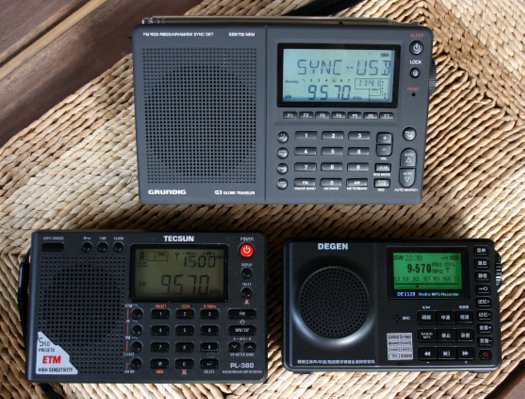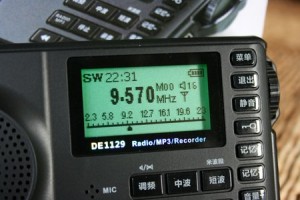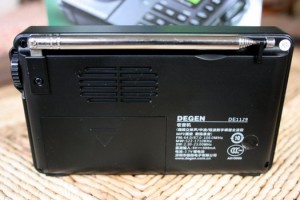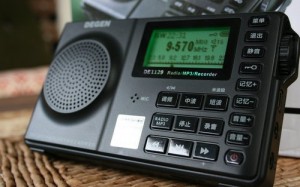
My Degen DE1129 as tested (Click to enlarge)
The Degen DE1129 is the latest compact, full-featured, DSP-based, AM/FM shortwave radio from Chinese manufacturer, Degen. It’s available from TecsunRadio.com at $100 US, shipped. I received my sample radio last week, and published my initial impressionsof the unit. Since then, I’ve had time to put this tiny radio through its paces and learn the functions of the various buttons labeled in Chinese, which I don’t read. In the following review, we’ll study the positive characteristics–and the drawbacks–of this little radio.
Getting started: the unit
I’ll begin by discussing some of the positive attributes of this radio. First, it should be noted that the DE1129 I have reviewed is one of the first to be produced, and as such, it currently has 18 buttons screen-printed in Chinese. Last week, Degen announced that they will be producing an English version, and (importantly) adding a number pad for keying in frequencies directly (see photo above). I have confirmed this via the manufacturer’s retailer. It will require squeezing a lot of buttons into a very small area, but I imagine this alteration will be easy enough, and probably remain functional even for those with larger fingers.
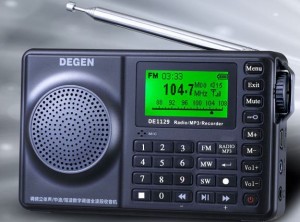
Degen has confirmed that they intend to produce a DE1129 with a number pad and English print in the future (Click to enlarge, Photo: Degen)
On the topic of buttons, those on the DE1129 are easy to push and have a very tactile response–very much like those on the Tecsun PL-380 and PL-390. I don’t expect these buttons are likely to be compressed accidentally if the radio is in your pocket, but just in case, there is a number lock button (with a key icon) that will further protect the radio.
The body of the radio is made of a hard, smooth plastic–without a rubberized coating–and seems durable enough. The speaker is not exactly flush-mounted. Instead, it protrudes from the rest of the body by about 1/4 inch. At first, I thought this quite odd, but I’m fairly sure this was in order to accommodate a larger speaker than it otherwise would have had.
For more on the DE1129 unit itself, be sure to read my initial impressions, which go into greater detail.
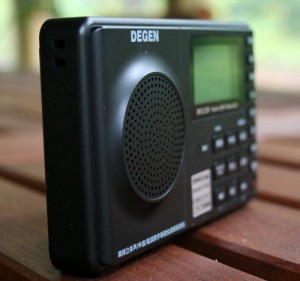
This little speaker packs a punch!
Audio
The audio from the built-in speaker is impressive–in fact, this is possibly the best feature of this little radio. Just the other day, I was able to listen to an NPR FM station, with the volume turned up, as I cooked a meal; typically, I wouldn’t be able to hear a radio this small while doing other things–the output would be tinny with too much emphasis on the treble end of the audio, and the sound lost in all but a quiet room. However, the DE1129 speaker offers just enough bass to keep the audio (especially on FM, or from a quality digital audio file) comparatively rich and full. In essence, it sounds like a larger radio. Though the speaker lacks a bit of mid-range, the overall experience of listening to AM is quite pleasant, while FM is exceptional.
Digital Audio Player/Recorder
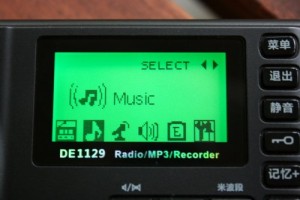
The “Music” mode will allow you to play pre-recorded MP3 files
With several of their latest DSP radios, Degen has added digital audio recording and playback features. The DE1129 is no exception, and offers the following capabilities:
- Records from a built-in microphone
- Records directly from the radio while playing
- Plays any MP3 formatted audio files
- Offers many standard music playback options, like repeat, shuffle, etc.
- Provides expandable memory via the insertion of a micro SD card into the radio, has 4GB of storage built-in
Perhaps the handiest feature is the fact that you can connect the Degen DE1129 to a PC, via supplied (standard) USB to miniUSB, for file transfer and maintenance. In my case, no additional software was needed for recognition of the DE1129 by my Windows 7 PC, which simply interpreted the radio as a storage device.
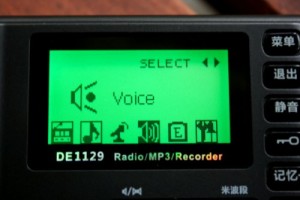
The “Voice” mode must be used to playback any recordings you make with the DE1129
NOTE: The DE1129 divides recordings into two different categories: “Music” or “Voice.” “Music” is basically any MP3 file that is stored in the root directory of the radio (when viewed on your PC). “Voice,” on the other hand, is stored in the “Voice” folder on the radio and is accessible only via the radio’s “Voice” mode. I could not find a way, for example, to record music on the FM radio and save it in the “Music” category–I believe anything that is recorded on the radio itself will be filed under “Voice.” Of course, you can connect the radio to your PC, then manually drag the files from the “Voice” folder into the root directory to have access within the “Music” mode. If you actually used the built-in microphone to make a live recording, it will also be saved under “Voice.”
My DE1129 came with two preloaded MP3s–a Kenny G song and a Chinese pop song. I added a few of my own choices and, again, was favorably impressed with audio fidelity from its tiny speaker.
Recording from the radio, however, was a different story…
First of all, a note of caution: I know that some of the DE1129’s predecessors had quality issues, when users tried recording from the radio without setting the volume to a very precise level. I assume that’s the reason why, when you record from the radio, the DE1129 auto-adjusts the volume level to a rather specific setting. Therefore, while the radio is recording, you cannot adjust the volume. This wouldn’t be a problem, save the fact that the volume level it sets is rather loud. The first time I tried recording from the radio, I was using in-ear, noise-cancelling headphones; the radio rapidly shot the volume level up to such a level that I had to jerk the phones out of my ears to protect them. In many situations, I find the volume level via the built-in speaker a little loud, as well. You will not be able to discreetly record your favorite show during church or while eating dinner with the in-laws! During recording, I believe this radio adjusts the volume to 20.
Oddly, while recording, the DE1129 will allow you to engage the mute function–it even shows you the audio muted icon–but it has no effect on the audio level, whatsoever.
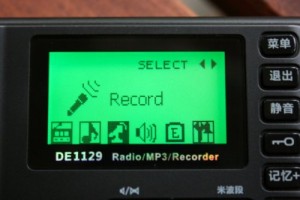
The “Record” mode is only used to record via the tiny built-in microphone–quality is quite good for voice
There are two levels of quality when recording: 129K or 96Kbps. Regardless of the setting, I find that there is a loss of quality when recording via the built-in recorder, though perhaps slightly less than with previous Degen models. When I recorded a stong FM station at 129K, I notice at least a 20% degradation in audio quality. The recorded audio sounds slightly muffled and garbled, more like an MP3 recording made at 48 Kbps. There was a noticeable lack of the higher and lower tones which make the DE1129’s internal speaker otherwise sound quite crisp.
There is a less noticable difference in audio quality while recording AM radio (whether shortwave or medium wave/AM). No doubt, this is due to the fact that AM radio lacks the higher and lower audio characteristics and general fidelity of FM radio. While AM recording quality is acceptable and content is intelligible, for playing back a recorded program, it certainly leaves a lot of room for improvement. As with FM recordings, AM recording sounds muffled.
I would not recommend purchasing the Degen DE1129 if you’re seeking an all-in-one unit to record quality radio on-the-go. If you can settle for a mediocre recording, and you don’t mind the fact that while you’re recording, the radio will be playing at fairly high volume, then this may be a useful feature.
Radio performance
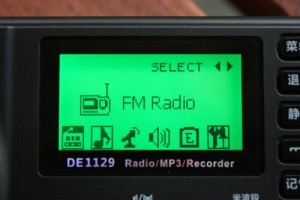
The “FM Radio” mode is actually the mode for all radio bands, including shortwave and medium wave
While I spent the bulk of my time testing the DE1129 on the shortwave and AM/MW bands, I will cover all three bands in order of performance, starting with the best.
FM
The Degen DE1129 is an excellent FM radio. In my tests, it received both strong and weak stations with relative ease and compared very favorably to my Eton S350DL, which I routinely use for receiving weaker FM stations in my area. Again, FM sounds great via the DE1129’s built-in speaker, providing nearly room-filling sound from a very tiny package.
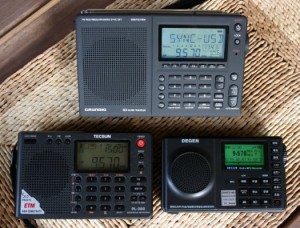
The DE1129 (lower right), with its competitors, the Grundig G3 (top) and Tecsun PL-380 (lower left)
Shortwave
I always spend the bulk of my radio review time on the shortwave bands, of course, and to test the DE1129, I pitted it against my trusty Tecsun PL-380 and Grundig G3. Note, however, that neither the G3 nor the PL-380 have recording capabilities.
Sensitivity
First, the good news. Shortwave sensitivity, in general, is fairly good on the Degen DE1129. With it, I was able to hear most of the weaker stations that were received by the PL-380 and G3. I believe adding a length of wire to the antenna with an alligator clip–as there is no external antenna jack–could slightly improve performance. I may test this further. Again, since the radio lacks a fold-out stand and the telescopic antenna cannot rotate, attaching a wire to the antenna will be less than practical, as this will tip the radio over.
But unfortunately, the DE1129 suffers from several shortcomings that make it the clear loser against its two similarly-priced competitors. Note that I mentioned a few of these problems in my initial impressions post. Here is more detail, by function:
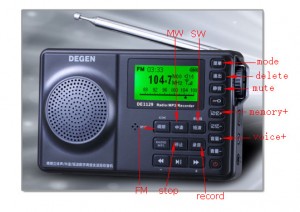
This image, with English translations for the keys on my DE1129, helped me identify each button’s function. Since there aren’t many buttons, I found that only after a few minutes of using the radio, I no longer needed to reference it. Click to enlarge
AGC (Automatic Gain Control)
The pre-defined AGC level is simply inadequate for comfortable shortwave radio listening of weaker signals. As mentioned above, though the radio has the sensitivity to detect the weak signals that its competitors can readily detect, the AGC gets in the way of comfortable listening. It creates a sort of pumping effect on weak stations, and truly seems to be “all or nothing:” at times, the radio’s signal will pop into clarity, then back into obscurity–obviously, it does not handle fading very well. The G3, in contrast, even without the sync detector engaged, did a much better job.
Bandwidth
The bandwidth is fixed–non-adjustable–on the DE1129. It is adequate for general shortwave broadcast listening, but a little too wide when you have two strong stations crowded together. Several times, adjacent broadcasts would bleed into the broadcast I was monitoring. I would expect even some rudimentary bandwidth control on a radio in the $100 US price category; the G3 (at $99) has wide/narrow, and the PL-380 (at $60 US) actually can be adjusted in 1 kHz increments from 6 kHz down to 1 kHz.
Single-Side Band
The DE1129 does NOT have SSB, thus would be useless for monitoring ham radio traffic, or listening to pirate radio stations in SSB, for example. The similarly-priced Grundig G3 does, of course, have SSB.

Shortwave can only be tuned in 5 kHz steps
Frequency steps
Unfortunately, the DE1129 has fixed frequency steps at 5 kHz; you cannot adjust it to be more or less. In comparison, both the PL-380 and G3 can be adjusted down to 1 kHz steps.
Since the DE1129 mutes between frequency changes, it creates a “chuffing” sound while band scanning or tuning much like the PL-380. The Grundig G3, in contrast, tunes with smooth, continuous sound–much like an analog radio.
Tuning Speed
I normally don’t bother commenting on tuning speed, but I find that band scanning on the DE1129 leaves something to be desired. It’s rather arduous.
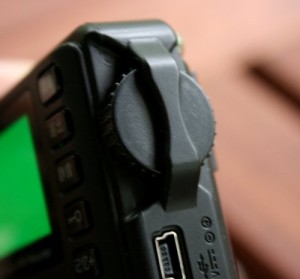
The DE1129’s hard plastic band covering the tuning wheel may protect it if dropped, but it’s also in the way of your thumb for easy tuning on the side
The tuning speed is not adaptive. Meaning, if I turn the tuning dial faster, it doesn’t increase the speed of tuning. This is very frustrating, especially since the model I reviewed does not have direct frequency entry via a number keypad. If I want to move from 5800 kHz to 6100 kHz, it takes a lot of tuning to get me there!
If I were stuck with the DE1129 as my only shortwave radio, I would be forced to fill its memory bank with all of my favorite frequencies, just to make tuning easier.
The DE1129 does have two different ways to navigate the shortwave spectrum:
- By pressing the “Shortwave” button repeatedly, the DE1129 will move you from one SW meter band to the next highest. This is the only practical way of tuning.
- The other way, (practical only if you want to listen to something outside of the normal broadcast meter bands) is to manually tune the entire SW spectrum (2.3 – 23 MHz) in 5kHz increments. Since the tuning rate is rather slow, this is a cumbersome process to say the least. To make it go a little faster, you could allocate memory locations, say at 3, 4, 5, 6 MHz etc. to make points (or bookmarks) from which you could tune.
Noise
My observation is that the radio’s internal processor and/or display seem to inject noise into the DE1129. This is especially noticeable on medium wave (see below).
While testing the radio against the G3 and PL-380, I even noticed that I could hear the (tuning) encoder noise of the DE1129, emanating from it, and even from other radios operating within two feet of it. Each tuning increment (via the tuning wheel) would produce a clicking sound in the audio of not only the DE1129, but even more noticably in that of other radios. The DE1129 is obviously generating a little RF noise of its own.
SW Summary
At $100 US, the DE1129 is simply not a good value for those interested in shortwave radio performance. Perhaps if it were in the $40-50 category, my expectations would be lower, and it might meet them at this price point. At the very least, a wide/narrow bandwidth control and the ability to speed up/slow down tuning speed would make this a more pleasant and functional radio. The sloppy AGC alone, though, would still keep me from recommending the DE1129 as a good shortwave radio.
AM/Medium Wave
On the positive side, the DE1129 can be used in any ITU region as the user can specify either 9kHz or 10 kHz spacing, although there is no option for choosing frequency steps less than 9 kHz.
How well does the DE1129 perform on medium wave? Not so well, I’m afraid–it’s mediocre at best. Medium wave suffers from many of the same problems as shortwave (described above), including the fact that the DE1129’s AGC (Auto Gain Control) simply cannot handle the up-and-down nature of weak AM stations.
Ticks like a clock?
Perhaps worst of all, though, is a “ticking” sound that plagues this Degen’s audio on the medium wave band. Spaced almost at second intervals, this “ticking” sound is present most anytime I listened to an AM broadcast. It was less noticeable in robust local broadcasts, but was still there, nonetheless. Recording a broadcast only seemed to make it more noticeable.
Unfortunately, if you purchase the DE1129 to listen to medium wave, you are likely to be disappointed.
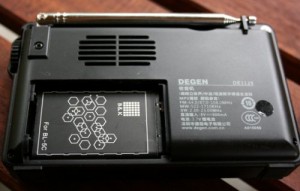
The DE1129’s thin rechargeable pack fits neatly into the battery compartment on the back of the unit
Battery
As mentioned in my initial impressions, the DE1129 operates on a slim 3.7V 850 mAh Li Ion battery pack. Unlike most other shortwave portables on the market (but similar to the Grundig G2 and Degen DE1128), it does not operate on AA batteries.
No doubt, the slender battery pack allows for the compact form factor of the DE1129. In my testing, I found that the battery life is very good. Indeed, I have not needed to re-charge the battery even though I’ve played the radio for many hours in testing. I cannot speak to the overall longevity of the battery pack, however.
While I’m sure these battery packs are convenient, I still prefer the traditional AA battery. If this battery pack wears out, I will have to order a replacement, whereas most portable radios only require the ubiquitous AA cell.
Stacking up the pros and cons
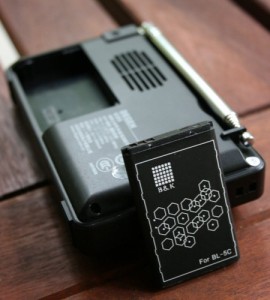
The rechargeable battery pack is very slim
Every radio has positive and negative attributes, and the DE1129 is no exception. Alas, in this case–especially since I’m reviewing this with a focus on shortwave and radio performance–the negatives outnumber the positives.
Pros:
- Audio from built in speaker is superb for size (see con)
- Sturdy, smooth plastic body (see con)
- Perfect small size for travel
- Strong FM radio performance
- Ability to record either via built-in microphone or directly from radio (see cons)
- One-button recording from any radio band
- Crisp, easy to read backlit display
- MP3 playback and functionality
- Simple interface via supplied USB cable to both charge the radio and add/maintain recordings and MP3s
- MW frequency steps can be adjusted between 9/10 kHz
- Up to 32 GB of additional storage via micro SD card
- Built-in microphone recordings of voice notes are excellent
Cons:
- DE1129 plastic body lacks a back-stand and telescopic antenna cannot rotate
- Shortwave performance is mediocre, AGC can’t handle weak signals and QSB
- Mediumwave performance is poor, AGC flounders on weak signals, and most of the MW band is plagued with a ticking noise
- Bandwidth cannot be changed and is too wide for crowded SW broadcast conditions
- No direct frequency entry (though Degen plans to add this very soon!)
- No complete (stand-alone) charging adapter; USB cable only, to plug into PC or wall-mounted USB charger
- Tuning rate is fixed on SW at 5 kHz and not adaptive if you turn the dial faster
- 4 or 5 second delay when turning radio on
- Additional delays in response when changing frequency, mode, band and starting/ending a recording
- Protective tuning knob strap prevents thumb tuning
- While recording from radio, the volume level will spike loudly and cannot be changed or muted regardless if using built-in speaker or headphones
- Recorded radio audio suffers from compression and is significantly degraded from the original broadcast–less noticeable on SW and MW/AM
- No external antenna jack
- No English manual (at time of this review, though I imagine this will be forthcoming)
- In the current firmware version, the radio mode is displayed as “FM Radio” in the menu selection, though this mode covers all radio bands
- There are no backlight options or modes that I could find–if you touch a control or move the frequency, the display will remain backlit for only about 10 seconds (please comment if you know how to change this)
Summary
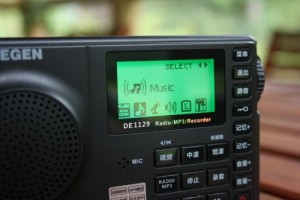 I really should have started this review with the following disclaimer: it is possible that there is functionality to this radio, and adjustments that can be made to it, that I have yet to discover. To my knowledge, I have toured and tried every menu option and explored every possibility with the radio’s settings. However, since this is an early production unit and all of the instructions are in Chinese, I could easily have missed something. Future firmware updates and the forthcoming numeric keypad could also change my opinion of the DE1129.
I really should have started this review with the following disclaimer: it is possible that there is functionality to this radio, and adjustments that can be made to it, that I have yet to discover. To my knowledge, I have toured and tried every menu option and explored every possibility with the radio’s settings. However, since this is an early production unit and all of the instructions are in Chinese, I could easily have missed something. Future firmware updates and the forthcoming numeric keypad could also change my opinion of the DE1129.
With that said, I can freely comment on my experience:
If you are looking for a very compact radio with good FM reception, with MP3 recording and playback, with a compact form factor and a wonderful built-in speaker, you may want to consider the Degen DE1129 in your search.
If you are seeking a good shortwave or mediumwave radio, however, I would look elsewhere.
Overall, I feel like the DE1129 has much room for improvement, and I hope Degen is listening and will make firmware upgrades to quickly address some of my criticisms above. It’s as if the DE1129 was built around the MP3/FM functionality and shortwave/mediumwave was simply an add-on, a bonus feature. I would never use the DE1129 for shortwave DXing, and certainly not for mediumwave DXing. The fact that the radio receives noise from its CPU–especially the ticking sound on MW–makes me believe that it was not thoroughly tested before production.
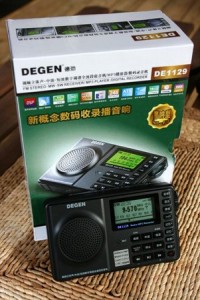
The Degen DE1129 & box (Click to enlarge)
For the price point (currently $100 US, shipped from the manufacturer), I simply expect better performance. In my tests, the Grundig G3 and Tecsun PL-380 outperformed the DE1129 in every respect on shortwave and mediumwave.
TecsunRadio.com provided a sample unit for this review and I paid for DHL shipping. I can say that I’ve been very pleased with customer service at TecsunRadio.com. Since they are in a different time zone, and English is their second language, communication was slow, but they answered my many questions.
To my knowledge, the Degen DE1129 is only available from TecsunRadio.com and can be purchased for $80 US plus $20 shipping internationally.
 Due to budget cuts, the American Forces Network (AFRTS) has decommissioned their Key West, Florida SW frequencies of: 5446, 7811, 12133 kHz
Due to budget cuts, the American Forces Network (AFRTS) has decommissioned their Key West, Florida SW frequencies of: 5446, 7811, 12133 kHz














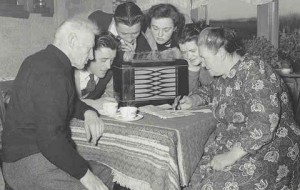
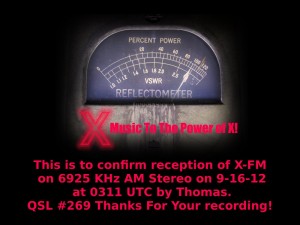
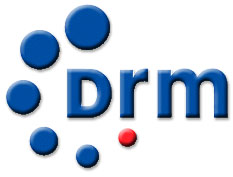
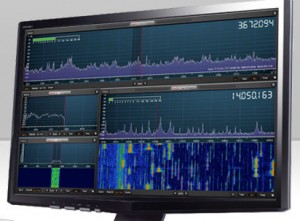 Andy Wilkinson (EI2HWB)
Andy Wilkinson (EI2HWB)  Though listening conditions were tough Saturday night, as we were wedged between two lines of thunderstorms (both of which were no more than 60 miles away) I did manage to capture North Woods Radio’s full broadcast. This broadcast featured some noted drum solos. As you can
Though listening conditions were tough Saturday night, as we were wedged between two lines of thunderstorms (both of which were no more than 60 miles away) I did manage to capture North Woods Radio’s full broadcast. This broadcast featured some noted drum solos. As you can 